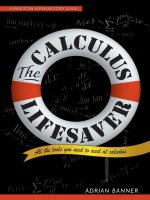Where Have All the Criminals Gone
Bạn đang xem bản rút gọn của tài liệu. Xem và tải ngay bản đầy đủ của tài liệu tại đây (1.29 MB, 28 trang )
4
Where Have All the
Criminals Gone?
In 1966, one year after Nicolae Ceaus¸escu became the Communist
dictator of Romania, he made abortion illegal. “The fetus is the prop-
erty of the entire society,” he proclaimed. “Anyone who avoids having
children is a deserter who abandons the laws of national continuity.”
Such grandiose declarations were commonplace during Ceau-
s¸escu’s reign, for his master plan—to create a nation worthy of the
New Socialist Man—was an exercise in grandiosity. He built palaces
for himself while alternately brutalizing and neglecting his citizens.
Abandoning agriculture in favor of manufacturing, he forced many of
the nation’s rural dwellers into unheated apartment buildings. He
gave government positions to forty family members including his
wife, Elena, who required forty homes and a commensurate supply of
fur and jewels. Madame Ceaus¸escu, known officially as the Best
Mother Romania Could Have, was not particularly maternal. “The
worms never get satisfied, regardless of how much food you give
them,” she said when Romanians complained about the food short-
FREAKONOMICS
ages brought on by her husband’s mismanagement. She had her own
children bugged to ensure their loyalty.
Ceaus¸escu’s ban on abortion was designed to achieve one of his
major aims: to rapidly strengthen Romania by boosting its popula-
tion. Until 1966, Romania had had one of the most liberal abortion
policies in the world. Abortion was in fact the main form of birth
control, with four abortions for every live birth. Now, virtually
overnight, abortion was forbidden. The only exemptions were moth-
ers who already had four children or women with significant standing
in the Communist Party. At the same time, all contraception and sex
education were banned. Government agents sardonically known as
the Menstrual Police regularly rounded up women in their work-
places to administer pregnancy tests. If a woman repeatedly failed to
conceive, she was forced to pay a steep “celibacy tax.”
Ceaus¸escu’s incentives produced the desired effect. Within one
year of the abortion ban, the Romanian birth rate had doubled. These
babies were born into a country where, unless you belonged to the
Ceaus¸escu clan or the Communist elite, life was miserable. But these
children would turn out to have particularly miserable lives. Com-
pared to Romanian children born just a year earlier, the cohort of chil-
dren born after the abortion ban would do worse in every measurable
way: they would test lower in school, they would have less success in
the labor market, and they would also prove much more likely to be-
come criminals.
The abortion ban stayed in effect until Ceaus¸escu finally lost his
grip on Romania. On December 16, 1989, thousands of people took
to the streets of Timisoara to protest his corrosive regime. Many of
the protestors were teenagers and college students. The police killed
dozens of them. One of the opposition leaders, a forty-one-year-old
professor, later said it was his thirteen-year-old daughter who insisted
he attend the protest, despite his fear. “What is most interesting is that
106
Where Have All the Criminals Gone?
we learned not to be afraid from our children,” he said. “Most were
aged thirteen to twenty.” A few days after the massacre in Timisoara,
Ceaus¸escu gave a speech in Bucharest before one hundred thousand
people. Again the young people were out in force. They shouted
down Ceaus¸escu with cries of “Timisoara!” and “Down with the
murderers!” His time had come. He and Elena tried to escape the
country with $1 billion, but they were captured, given a crude trial,
and, on Christmas Day, executed by firing squad.
Of all the Communist leaders deposed in the years bracketing the
collapse of the Soviet Union, only Nicolae Ceaus¸escu met a violent
death. It should not be overlooked that his demise was precipitated in
large measure by the youth of Romania—a great number of whom,
were it not for his abortion ban, would never have been born at all.
The story of abortion in Romania might seem an odd way to begin
telling the story of American crime in the 1990s. But it’s not. In one
important way, the Romanian abortion story is a reverse image of the
American crime story. The point of overlap was on that Christmas
Day of 1989, when Nicolae Ceaus¸escu learned the hard way—with a
bullet to the head—that his abortion ban had much deeper implica-
tions than he knew.
On that day, crime was just about at its peak in the United States.
In the previous fifteen years, violent crime had risen 80 percent. It was
crime that led the nightly news and the national conversation.
When the crime rate began falling in the early 1990s, it did so with
such speed and suddenness that it surprised everyone. It took some
experts many years to even recognize that crime was falling, so confi-
dent had they been of its continuing rise. Long after crime had
peaked, in fact, some of them continued to predict ever darker sce-
narios. But the evidence was irrefutable: the long and brutal spike in
107
FREAK ONOMIC S
crime was moving in the opposite direction, and it wouldn’t stop until
the crime rate had fallen back to the levels of forty years earlier.
Now the experts hustled to explain their faulty forecasting. The
criminologist James Alan Fox explained that his warning of a “blood-
bath” was in fact an intentional overstatement. “I never said there
would be blood flowing in the streets,” he said, “but I used strong
terms like ‘bloodbath’ to get people’s attention. And it did. I don’t
apologize for using alarmist terms.” (If Fox seems to be offering a dis-
tinction without a difference—“bloodbath” versus “blood flowing in
the streets”—we should remember that even in retreat mode, experts
can be self-serving.)
After the relief had settled in, after people remembered how to go
about their lives without the pressing fear of crime, there arose a nat-
ural question: just where did all those criminals go?
At one level, the answer seemed puzzling. After all, if none of the
criminologists, police officials, economists, politicians, or others who
traffic in such matters had foreseen the crime decline, how could they
suddenly identify its causes?
But this diverse army of experts now marched out a phalanx of
hypotheses to explain the drop in crime. A great many newspaper
articles would be written on the subject. Their conclusions often
hinged on which expert had most recently spoken to which reporter.
Here, ranked by frequency of mention, are the crime-drop explana-
tions cited in articles published from 1991 to 2001 in the ten largest-
circulation papers in the LexisNexis database:
C
RIME
-D
ROP
E
XPLANATION
N
UMBER OF
C
ITATIO N S
1. Innovative policing strategies 52
2. Increased reliance on prisons 47
3. Changes in crack and other drug markets 33
4. Aging of the population 32
108
Where Have All the Criminals Gone?
C
RIME
-D
ROP
E
XPLANATION
N
UMBER OF
C
ITATIO N S
5. Tougher gun-control laws 32
6. Strong economy 28
7. Increased number of police 26
8. All other explanations (increased use of 34
capital punishment, concealed-weapons
laws, gun buybacks, and others)
If you are the sort of person who likes guessing games, you may
wish to spend the next few moments pondering which of the preced-
ing explanations seem to have merit and which don’t. Hint: of the
seven major explanations on the list, only three can be shown to have
contributed to the drop in crime. The others are, for the most part,
figments of someone’s imagination, self-interest, or wishful thinking.
Further hint: one of the greatest measurable causes of the crime drop
does not appear on the list at all, for it didn’t receive a single news-
paper mention.
Let’s begin with a fairly uncontroversial one: the strong economy. The
decline in crime that began in the early 1990s was accompanied by a
blistering national economy and a significant drop in unemployment.
It might seem to follow that the economy was a hammer that helped
beat down crime. But a closer look at the data destroys this theory. It
is true that a stronger job market may make certain crimes relatively
less attractive. But that is only the case for crimes with a direct finan-
cial motivation—burglary, robbery, and auto theft—as opposed to vi-
olent crimes like homicide, assault, and rape. Moreover, studies have
shown that an unemployment decline of 1 percentage point accounts
for a 1 percent drop in nonviolent crime. During the 1990s, the un-
employment rate fell by 2 percentage points; nonviolent crime,
109
FREAKONOMICS
meanwhile, fell by roughly 40 percent. But an even bigger flaw in the
strong-economy theory concerns violent crime. Homicide fell at a
greater rate during the 1990s than any other sort of crime, and a num-
ber of reliable studies have shown virtually no link between the econ-
omy and violent crime. This weak link is made even weaker by
glancing back to a recent decade, the 1960s, when the economy went
on a wild growth spurt—as did violent crime. So while a strong 1990s
economy might have seemed, on the surface, a likely explanation for
the drop in crime, it almost certainly didn’t affect criminal behavior in
any significant way.
Unless, that is, “the economy” is construed in a broader sense—as
a means to build and maintain hundreds of prisons. Let’s now con-
sider another crime-drop explanation: increased reliance on prisons. It
might help to start by flipping the crime question around. Instead of
wondering what made crime fall, think about this: why had it risen so
dramatically in the first place?
During the first half of the twentieth century, the incidence of vio-
lent crime in the United States was, for the most part, fairly steady. But
in the early 1960s, it began to climb. In retrospect, it is clear that one
of the major factors pushing this trend was a more lenient justice sys-
tem. Conviction rates declined during the 1960s, and criminals who
were convicted served shorter sentences. This trend was driven in part
by an expansion in the rights of people accused of crimes—a long
overdue expansion, some would argue. (Others would argue that the
expansion went too far.) At the same time, politicians were growing
increasingly softer on crime—“for fear of sounding racist,” as the
economist Gary Becker has written, “since African-Americans and
Hispanics commit a disproportionate share of felonies.” So if you were
the kind of person who might want to commit a crime, the incentives
were lining up in your favor: a slimmer likelihood of being convicted
and, if convicted, a shorter prison term. Because criminals respond to
incentives as readily as anyone, the result was a surge in crime.
110
Where Have All the Criminals Gone?
It took some time, and a great deal of political turmoil, but these
incentives were eventually curtailed. Criminals who would have pre-
viously been set free—for drug-related offenses and parole revocation
in particular—were instead locked up. Between 1980 and 2000, there
was a fifteenfold increase in the number of people sent to prison on
drug charges. Many other sentences, especially for violent crime, were
lengthened. The total effect was dramatic. By 2000, more than two
million people were in prison, roughly four times the number as of
1972. Fully half of that increase took place during the 1990s.
The evidence linking increased punishment with lower crime rates
is very strong. Harsh prison terms have been shown to act as both de-
terrent (for the would-be criminal on the street) and prophylactic (for
the would-be criminal who is already locked up). Logical as this may
sound, some criminologists have fought the logic. A 1977 academic
study called “On Behalf of a Moratorium on Prison Construction”
noted that crime rates tend to be high when imprisonment rates are
high, and concluded that crime would fall if imprisonment rates
could only be lowered. (Fortunately, jailers did not suddenly turn
loose their wards and sit back waiting for crime to fall. As the political
scientist John J. DiIulio Jr. later commented, “Apparently, it takes a
Ph.D. in criminology to doubt that keeping dangerous criminals in-
carcerated cuts crime.”)
The “Moratorium” argument rests on a fundamental confusion of
correlation and causality. Consider a parallel argument. The mayor of
a city sees that his citizens celebrate wildly when their team wins the
World Series. He is intrigued by this correlation but, like the “Mora-
torium” author, fails to see the direction in which the correlation runs.
So the following year, the mayor decrees that his citizens start cele-
brating the World Series before the first pitch is thrown—an act that, in
his confused mind, will ensure a victory.
There are certainly plenty of reasons to dislike the huge surge in
the prison population. Not everyone is pleased that such a significant
111
FREAKONOMICS
fraction of Americans, especially black Americans, live behind bars.
Nor does prison even begin to address the root causes of crime, which
are diverse and complex. Lastly, prison is hardly a cheap solution: it
costs about $25,000 a year to keep someone incarcerated. But if the
goal here is to explain the drop in crime in the 1990s, imprisonment
is certainly one of the key answers. It accounts for roughly one-third
of the drop in crime.
Another crime-drop explanation is often cited in tandem with im-
prisonment: the increased use of capital punishment. The number of exe-
cutions in the United States quadrupled between the 1980s and the
1990s, leading many people to conclude—in the context of a debate
that has been going on for decades—that capital punishment helped
drive down crime. Lost in the debate, however, are two important facts.
First, given the rarity with which executions are carried out in this
country and the long delays in doing so, no reasonable criminal
should be deterred by the threat of execution. Even though capital
punishment quadrupled within a decade, there were still only 478 ex-
ecutions in the entire United States during the 1990s. Any parent
who has ever said to a recalcitrant child, “Okay, I’m going to count to
ten and this time I’m really going to punish you,” knows the differ-
ence between deterrent and empty threat. New York State, for in-
stance, has not as of this writing executed a single criminal since
reinstituting its death penalty in 1995. Even among prisoners on
death row, the annual execution rate is only 2 percent—compared
with the 7 percent annual chance of dying faced by a member of the
Black Gangster Disciple Nation crack gang. If life on death row is
safer than life on the streets, it’s hard to believe that the fear of execu-
tion is a driving force in a criminal’s calculus. Like the $3 fine for late-
arriving parents at the Israeli day-care centers, the negative incentive
of capital punishment simply isn’t serious enough for a criminal to
change his behavior.
112
Where Have All the Criminals Gone?
The second flaw in the capital punishment argument is even more
obvious. Assume for a moment that the death penalty is a deterrent.
How much crime does it actually deter? The economist Isaac Ehrlich,
in an oft-cited 1975 paper, put forth an estimate that is generally con-
sidered optimistic: executing 1 criminal translates into 7 fewer homi-
cides that the criminal might have committed. Now do the math. In
1991, there were 14 executions in the United States; in 2001, there
were 66. According to Ehrlich’s calculation, those 52 additional exe-
cutions would have accounted for 364 fewer homicides in 2001—not
a small drop, to be sure, but less than 4 percent of the actual decrease
in homicides that year. So even in a death penalty advocate’s best-case
scenario, capital punishment could explain only one twenty-fifth of
the drop in homicides in the 1990s. And because the death penalty is
rarely given for crimes other than homicide, its deterrent effect can-
not account for a speck of decline in other violent crimes.
It is extremely unlikely, therefore, that the death penalty, as cur-
rently practiced in the United States, exerts any real influence on
crime rates. Even many of its onetime supporters have come to this
conclusion. “I feel morally and intellectually obligated simply to con-
cede that the death penalty experiment has failed,” said U.S. Supreme
Court Justice Harry A. Blackmun in 1994, nearly twenty years after
he had voted for its reinstatement. “I no longer shall tinker with the
machinery of death.”
So it wasn’t capital punishment that drove crime down, nor was it the
booming economy. But higher rates of imprisonment did have a lot to
do with it. All those criminals didn’t march into jail by themselves, of
course. Someone had to investigate the crime, catch the bad guy, and
put together the case that would get him convicted. Which naturally
leads to a related pair of crime-drop explanations:
113
FREAKONOMICS
Innovative policing strategies
Increased number of police
Let’s address the second one first. The number of police officers per
capita in the United States rose about 14 percent during the 1990s.
Does merely increasing the number of police, however, reduce crime?
The answer would seem obvious—yes—but proving that answer isn’t
so easy. That’s because when crime is rising, people clamor for protec-
tion, and invariably more money is found for cops. So if you just look
at raw correlations between police and crime, you will find that when
there are more police, there tends to be more crime. That doesn’t
mean, of course, that the police are causing the crime, just as it doesn’t
mean, as some criminologists have argued, that crime will fall if crim-
inals are released from prison.
To show causality, we need a scenario in which more police are
hired for reasons completely unrelated to rising crime. If, for instance,
police were randomly sprinkled in some cities and not in others, we
could look to see whether crime declines in the cities where the police
happen to land.
As it turns out, that exact scenario is often created by vote-hungry
politicians. In the months leading up to Election Day, incumbent
mayors routinely try to lock up the law-and-order vote by hiring more
police—even when the crime rate is standing still. So by comparing
the crime rate in one set of cities that have recently had an election
(and which therefore hired extra police) with another set of cities that
had no election (and therefore no extra police), it’s possible to tease
out the effect of the extra police on crime. The answer: yes indeed, ad-
ditional police substantially lower the crime rate.
Again, it may help to look backward and see why crime had risen
so much in the first place. From 1960 to 1985, the number of police
officers fell more than 50 percent relative to the number of crimes. In
114
Where Have All the Criminals Gone?
some cases, hiring additional police was considered a violation of the
era’s liberal aesthetic; in others, it was simply deemed too expensive.
This 50 percent decline in police translated into a roughly equal de-
cline in the probability that a given criminal would be caught. Cou-
pled with the above-cited leniency in the other half of the criminal
justice system, the courtrooms, this decrease in policing created a
strong positive incentive for criminals.
By the 1990s, philosophies—and necessities—had changed. The
policing trend was put in reverse, with wide-scale hiring in cities
across the country. Not only did all those police act as a deterrent, but
they also provided the manpower to imprison criminals who might
have otherwise gone uncaught. The hiring of additional police ac-
counted for roughly 10 percent of the 1990s crime drop.
But it wasn’t only the number of police that changed in the 1990s;
consider the most commonly cited crime-drop explanation of all:
innovative policing strategies.
There was perhaps no more attractive theory than the belief that
smart policing stops crime. It offered a set of bona fide heroes rather
than simply a dearth of villains. This theory rapidly became an article
of faith because it appealed to the factors that, according to John Ken-
neth Galbraith, most contribute to the formation of conventional
wisdom: the ease with which an idea may be understood and the de-
gree to which it affects our personal well-being.
The story played out most dramatically in New York City, where
newly elected mayor Rudolph Giuliani and his handpicked police
commissioner, William Bratton, vowed to fix the city’s desperate
crime situation. Bratton took a novel approach to policing. He ush-
ered the NYPD into what one senior police official later called “our
Athenian period,” in which new ideas were given weight over calcified
practices. Instead of coddling his precinct commanders, Bratton de-
manded accountability. Instead of relying solely on old-fashioned cop
115









